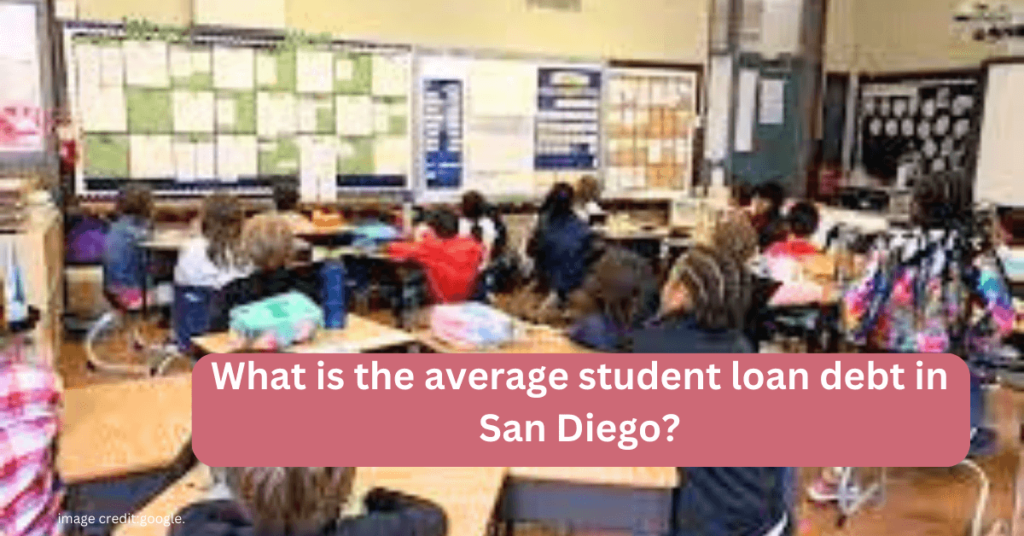What is the average student loan debt in San Diego?:What You Need to Know Student loan debt is a growing concern across the United States, with millions of graduates burdened by financial obligations long after they have completed their studies. In cities like San Diego, the combination of high tuition costs and a relatively high cost of living only exacerbates the challenges that recent graduates face. So, what is the average student loan debt in San Diego, and how does it compare to the national average? This article delves into the financial landscape of student loans in San Diego, providing insights into factors that contribute to the debt burden, the typical loan amounts, and strategies to manage repayment.

What is the Average Student Loan Debt in San Diego?
When considering the average student loan debt in San Diego, it’s important to recognize that the amount can vary depending on several factors, including the type of institution attended, whether the student is an in-state or out-of-state resident, and the repayment plan chosen. On average, San Diego graduates tend to carry significant student loan debt, with figures generally higher than the national average.
As of the latest available data, the average student loan debt in San Diego is estimated to be around $28,000 to $35,000. This is in line with trends seen in other major cities in California. This debt is accumulated from a variety of sources, including federal loans, private loans, and institutional loans. The amount of debt varies greatly depending on the type of school attended. For example, graduates of private universities like the University of San Diego or Point Loma Nazarene University may face higher debt compared to those who attend public institutions such as San Diego State University.
While these figures provide a general picture of student loan debt, it’s essential to understand that the total loan amount can differ depending on the major, family income, and the student’s financial decisions during their time in school. For example, students who choose more expensive programs or out-of-state schools may end up with higher debt, while those who receive substantial financial aid may leave with less.
Factors Influencing the Average Student Loan Debt in San Diego
- High Tuition Costs
One of the most significant contributors to the average student loan debt in San Diego is the high cost of tuition. In California, tuition costs are among the highest in the nation, especially for out-of-state students. For example, in-state tuition at public universities like San Diego State University may cost around $18,000 annually, while out-of-state students could pay upwards of $36,000 per year. Private universities in San Diego, such as the University of San Diego, often have tuition rates that exceed $50,000 annually. These costs can add up quickly, leading to substantial student loan debt for those who need to borrow to cover their education. - Living Expenses and the Cost of Living
In addition to tuition costs, the average student loan debt in San Diego is also influenced by the relatively high cost of living in the city. San Diego is one of the most expensive cities in California, with high housing costs, transportation expenses, and daily living needs. Rent prices in San Diego can be steep, with the average rent for a one-bedroom apartment in the city hovering around $2,000 per month. These expenses can put a strain on students, forcing them to borrow more money to cover living costs in addition to tuition. Consequently, many students find themselves graduating with higher-than-average student loan debt. - Type of Loan and Interest Rates
The type of loan that students take out can also impact the average student loan debt in San Diego. Federal student loans tend to have lower interest rates and more flexible repayment options compared to private loans, which may carry higher interest rates. Students who rely heavily on private loans to fund their education may face higher monthly payments and more significant debt burdens. Additionally, loan terms, such as the repayment period, can affect the overall debt accumulation. Graduates who take longer repayment periods to reduce monthly payments may end up paying more in interest over time, further increasing their total debt. - Graduate Program Debt
Graduate and professional school students in San Diego often face significantly higher student loan debt compared to undergraduates. Programs such as law, medicine, and business tend to have hefty tuition fees, often surpassing $50,000 per year at private universities. Graduates from these programs, particularly those in high-demand fields, may accrue debt amounts well above the average undergraduate loan burden, sometimes exceeding $100,000. For students pursuing advanced degrees, the average student loan debt in San Diego can therefore be much higher than what is typical for undergraduate students.
How Does San Diego Compare to Other Cities in Terms of Student Loan Debt?
When compared to other major cities in the United States, San Diego’s average student loan debt tends to be on the higher end. Many factors, including California’s high tuition rates and the high cost of living, contribute to this situation. However, it’s important to note that San Diego also has a relatively high median income compared to other cities in California, which can help offset some of the financial burden of student loan payments.
In comparison to other metropolitan areas, the average student loan debt in San Diego is slightly higher than cities like Dallas or Chicago but somewhat lower than areas like New York City, where student loan debt can be substantially more, largely due to higher tuition fees and living expenses. Nationally, the average student loan debt in the U.S. is approximately $30,000, so San Diego’s figures are fairly in line with national trends, though some individuals may carry debt that exceeds this amount depending on their unique circumstances.
Strategies for Managing Student Loan Debt in San Diego
For those grappling with the average student loan debt in San Diego, there are several strategies available to help manage and reduce debt over time:
- Income-Driven Repayment Plans
Federal student loans offer income-driven repayment (IDR) plans, which can significantly reduce monthly payments for graduates. These plans are based on a borrower’s income and family size, meaning that monthly payments could be as low as $0 for individuals who earn below a certain threshold. Graduates in San Diego who are struggling with student loan payments may find these plans particularly useful, as the cost of living can be challenging, especially for recent graduates working in lower-paying fields. - Refinancing Loans
Another option for graduates is refinancing their student loans. Refinancing involves consolidating existing loans into a new loan with a potentially lower interest rate. This could reduce monthly payments or shorten the loan term, allowing borrowers to pay off their debt more quickly. However, refinancing is best suited for individuals with good credit scores and stable income, as it can be difficult to refinance federal loans into private loans without losing certain protections such as income-driven repayment options or loan forgiveness programs. - Explore Loan Forgiveness Programs
For graduates who choose to work in public service or other qualifying fields, loan forgiveness programs such as the Public Service Loan Forgiveness (PSLF) program can be incredibly beneficial. In San Diego, graduates working for government agencies, non-profit organizations, or certain other qualifying employers may be eligible for PSLF after making 120 qualifying payments. This program can alleviate some of the financial burden by canceling the remaining loan balance after 10 years of qualifying payments. - Take Advantage of Employer Assistance
Some employers in San Diego may offer student loan repayment assistance as part of their employee benefits package. Graduates should check with their employers to see if this type of assistance is available. Employer-sponsored student loan repayment programs can help reduce debt more quickly and make monthly payments more manageable. - Budget and Financial Planning
Effective budgeting is crucial for managing the average student loan debt in San Diego. By carefully planning for monthly expenses, graduates can ensure that they prioritize their loan repayments without sacrificing other important financial goals, such as saving for retirement or emergencies. Consulting a financial advisor can help provide personalized strategies for managing debt and creating a sustainable budget.
Conclusion: Navigating Student Loan Debt in San Diego
The average student loan debt in San Diego is substantial, reflecting the high cost of education and the expensive living environment in the city. However, with the right tools and strategies, graduates can successfully manage and reduce their student loan obligations. From income-driven repayment plans to loan forgiveness programs, there are various ways to ease the financial burden of student loans. By staying informed about available options and maintaining sound financial habits, graduates in San Diego can achieve financial stability and work toward paying off their student debt in a manageable way.

